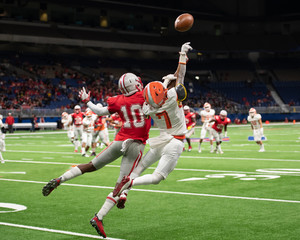Eligible recipients
In American football, not all players on offense are eligible for a forward pass. Only a qualified pass receiver may legally catch a forward pass, and only a qualified receiver may advance beyond the neutral zone if a forward pass crosses the neutral zone.
A forward pass is to throw the ball in the direction that the offensive team is trying to move, towards the defensive team’s goal line.
The neutral zone is an area where no member of any of the teams is allowed to be, except the one holding the ball. The neutral zone exists only when the ball is not in play, as before a snap that starts the game. Knowing if the ball has passed the neutral zone or stopped in or behind the neutral zone is important to determine if a forward pass has taken place.
For each game, the offense is required to have seven players lined up directly on the scrimmage line and four behind it. The quarterback is one of these four, and the others are usually running backs, fullbacks, tight ends and slot receivers. Six of the 11 attacking players are qualified receivers and can catch a forward pass. The other five are unauthorized recipients. When the ball is caught by a legitimate receiver, the linemen can go down to block.
Every player on the defensive side is considered a qualified receiver. All players on offense or defense can catch a back or side pass. The pass must be parallel to or away from the opponents’ goal line.
Unqualified recipient Downfield Penalty
If an impermissible receiver is beyond the neutral zone when a forward pass crossing the neutral zone is thrown, it would be an example of an impermissible receiver down. The penalty is worth the loss of five yards, but no loss of down is called.
If the passport is received by a non-qualified recipient, it is called illegal contact. That penalty is worth the loss of five yards and the loss of down.
So, for example, if one of the five offensive linemen goes over the neutral zone and a forward pass is thrown down, this would be a penalty.
Why Jersey numbers are important
There is a connection between eligible recipients and the numbering system for football shirts. In college football, the rulebook states that qualified receivers must carry a uniform number other than 50 to 79. This makes it easier for the officer crew to determine who is an eligible receiver and who is not once the game has been initiated. If a player is to switch between qualified and unqualified positions, they must physically change jersey numbers to reflect the position.
In the NFL, qualified receivers must also wear certain uniform numbers for the same reason. In the NFL, running backs must carry numbers 20 to 49, tight ends must carry numbers 80 to 89, or if they are exhausted, then 40 to 49, and wide receivers must carry numbers 10 to 19 or 80 to 89.
An NFL player who does not carry a uniform number that corresponds to a qualified receiver is not qualified even if that player is in a qualified position. There is an exception. If that player reports to the referee before the game the intention to qualify for the following games, that player may line up and act as a qualified receiver.

